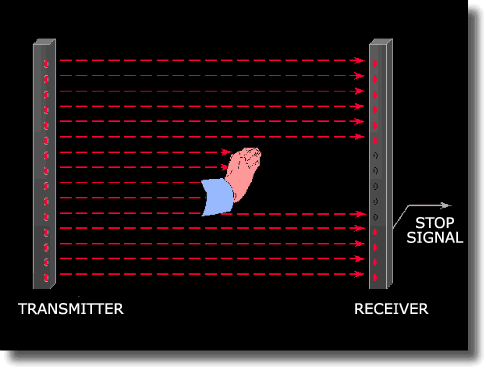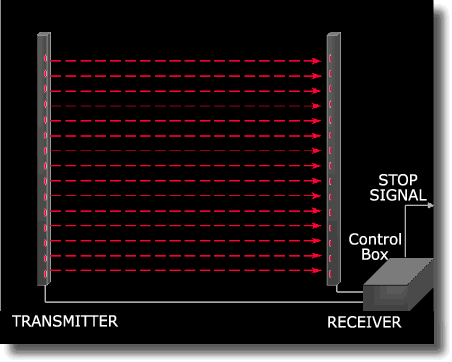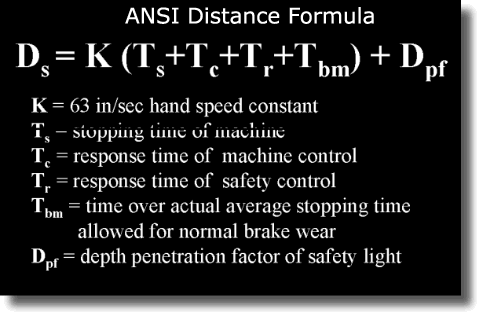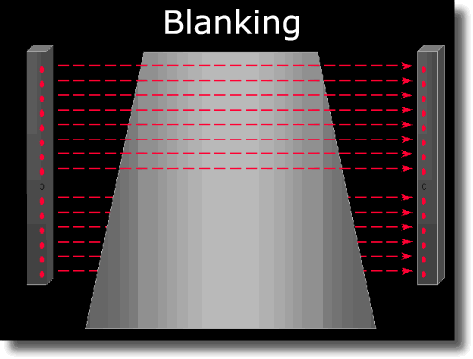
What's New
Products
Dealers
Support
OSHA Seminar
LINK's Links
About LINK
Feedback
Presence Sensing Devices - Introduction
Presence Sensing Devices, also known as "Light Curtains" have been around for over 25 years. There are over 15-20 different Presence Sensing Device manufacturers/marketers. There are two basic choices for Presence Sensing Devices on the market, the 2-box system, and the 3-box system.
- 2 - box systems
- Transmitter and Receiver
- 3 - box systems
- Transmitter, Receiver, and Control box
- Presence Sensing Devices are now commonly being used to replace traditional guarding methods
- Pull-backs, Type A & B gates, Fixed barrier guards
- They have many significant advantages over the traditional guarding methods:
- Freedom of movement for operator
- Flexibility of use, increased mounting options
- Reduction of operator fatigue
- Presence Sensing Devices increase productivity through:
- Quick set-up
- Less Maintenance
- Increased visibility of work area
Presence Sensing Devices - Basic Operation
The Transmitter unit sends modulated infrared light from LED array to a corresponding array of photo-transistors in the receiver unit.
When an opaque object interrupts one or more of the beams, the light curtain sends a stop signal to the guarded machine.
Typically, the infrared light is both pulsed and sequenced at a specific frequency. This is so the photo-transistors in the receiver unit may be designed to accept only the signal from the specific corresponding transmitter. This helps eliminate the acceptance of ambient light or light from other external sources.
No electrical connection is required between transmitter and receiver. Both are independently powered.
In a 2 - Box system: -Receiver must be wired to main press control enclosure for interface of “stop signal”.
In a 3 - Box system -Both receiver and transmitter must be cabled to the third box (i.e. presence sensing device control box), which in turn is wired back to the main press control enclosure for interface of “stop signal”.
With 3 - Box systems, the “logic” elements are in the third (i.e. control) box. This typically allows for a smaller profile for the transmitter and receiver, which can increase the mounting options for the system, but slightly increases amount of interconnection and wiring.
Presence Sensing Devices - Mounting
Lights must be mounted the proper distance from the closest pinch-point as determined by the distance formula. The OSHA formula for distance is as follows:
The Ansi formula takes into account some additional factors that affect overall stopping time of the machine, and is listed below:
Presence Sensing Devices - Control Reliability
“The device shall be designed and constructed so that any single component failure, including output devices, shall not prevent the normal STOP command from being sent to the press, but shall prevent operation of the press stroke until the failure has been corrected. In the event of a power failure to the device, it shall initiate a STOP command to the press control system.”
ANSI B11.1-1988 6.3.2(9)
To meet this requirement manufacturers typically use self-checking circuitry to monitor the Presence Sensing Device for internal faults. The requirement for control reliability applies to the composite control system. If the press clutch/brake control system does not meet control reliability requirements, addition of a presence sensing device will not bring the composite control into compliance.
If internal fault is detected:
- a stop signal is sent to machine control
- the presence sensing device goes to locked condition
- it remains so until failed component is replaced
- a controlled reset must be used to restore to operative condition
Presence Sensing Devices - Other Terms
Blanking:
Blocking out one or more beams to allow material or tooling to extend through sensing field without sending stop signal
Floating window:
Allows any one beam to be interrupted without stopping the press. The interrupted beam moves as material passes through the sensing field
- particularly useful in bending operations with press brakes.
Muting:
- The protective function is bypassed (muted) during the non-hazarduous portion of the stroke (i.e. the upstroke).
- Used primarily for hand-fed operations or where parts ejection would interrupt sensing field and stop press.
Presence Sensing Devices - Conclusions
The light curtain leads to the initiation of stopping action of the machine. It does this by sending a stop signal to the machine's control system. The machine’s control system and brake must be functioning properly in order to stop the machine.
The requirement for control reliability applies to the composite control system. If the press clutch/brake control system does not meet control reliability requirements, addition of a presence sensing device will not bring the composite control into compliance.
Do not use light curtains on full-revolution presses or other machines which cannot be stopped in mid-cycle !






